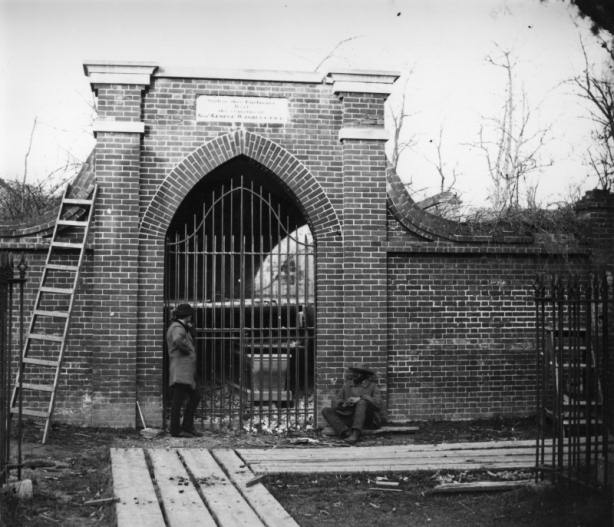Where George Washington Lies
Roger Hudson explains the story behind a 19th-century photograph of George Washington's mausoleum.
 The mausoleum containing the tombs of George Washington and his wife Martha, at his home, Mount Vernon in Virginia, undergoes repair in 1859. Washington had died in 1799 and left instructions in his will that he should be buried in a new family mausoleum, but this was not constructed until 1831, the centennial of his birth. This date, a transitional moment in architecture, is reflected stylistically in the combination of vaguely Classical pilasters to either side with a central Gothic arch. There are two stone obelisks set back from it and the iron railings round each of them can be seen. The inscription on the tablet above the arch, eloquent in its brevity, reads: ‘Within this enclosure rest the remains of General George Washington.’ The Washington family fell on hard times in the 19th century and needed to disencumber itself of Mount Vernon, but when it was offered to the Virginia and then to the US government in 1848, both refused to buy it. Eventually it was bought by the Mount Vernon Ladies’ Association of the Union in 1858, which no doubt put in hand the restoration in progress in this picture. In retrospect there is a certain irony in this taking place just before the outbreak of the Civil War, the greatest threat to the Union, which was to rage all round the area, although Mount Vernon itself was treated as neutral territory.
The mausoleum containing the tombs of George Washington and his wife Martha, at his home, Mount Vernon in Virginia, undergoes repair in 1859. Washington had died in 1799 and left instructions in his will that he should be buried in a new family mausoleum, but this was not constructed until 1831, the centennial of his birth. This date, a transitional moment in architecture, is reflected stylistically in the combination of vaguely Classical pilasters to either side with a central Gothic arch. There are two stone obelisks set back from it and the iron railings round each of them can be seen. The inscription on the tablet above the arch, eloquent in its brevity, reads: ‘Within this enclosure rest the remains of General George Washington.’ The Washington family fell on hard times in the 19th century and needed to disencumber itself of Mount Vernon, but when it was offered to the Virginia and then to the US government in 1848, both refused to buy it. Eventually it was bought by the Mount Vernon Ladies’ Association of the Union in 1858, which no doubt put in hand the restoration in progress in this picture. In retrospect there is a certain irony in this taking place just before the outbreak of the Civil War, the greatest threat to the Union, which was to rage all round the area, although Mount Vernon itself was treated as neutral territory.
How did it come about that the remains of this towering figure in American history were left in peace at Mount Vernon and that no public memorial to his memory was raised elsewhere for many decades after his death? That he was seen as a symbol of the Federalist Party was enough to ensure the opposition of the Jeffersonian Republicans to anything being erected; the Southern States resisted any attempt to move him from their soil. The Washington Monument in Washington DC, the world’s largest obelisk, was begun in 1848, but it took until 1884 to be completed.
The photograph was taken by William England, who was sent to America by the London Stereoscopic Company at this time. A
stereograph consisted of two photographs of the same scene slightly offset mounted on a card which, when viewed through the lenses of a stereoscope, produced a three-dimensional effect, with an illusion of depth. They were enormously popular and by 1860 there were a million stereoscopes in British homes. The most famous pictures that England took on his trip were of the French tightrope walker Blondin crossing the Niagara Falls. They became the most popular stereographs of all time, with over 100,000 cards sold.




